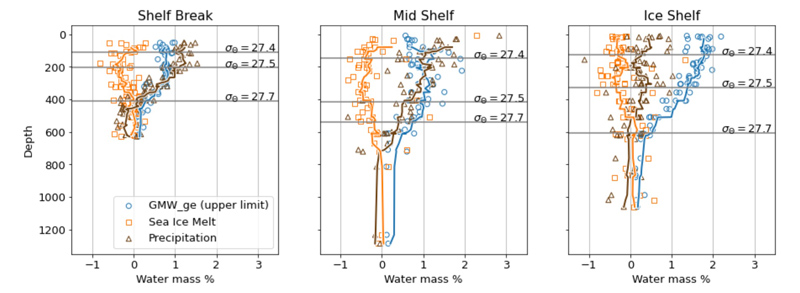Meeting Documents
Precipitation and Ventilation Within Circumpolar Waters of the Eastern Amundsen Sea
Presented at: AGU Annual Meeting 2024
Abstract

The Amundsen Sea region has exhibited some of the fastest glacial thinning and retreat in all of Antarctica yielding large inputs of freshwater to the region as well as downstream. Glacial melt was thought to dominate the freshwater budget, but a comparison of meltwater tracers suggests that precipitation may also be major contributor to freshwater flux. We took a closer look at the magnitude of precipitation derived from oxygen-18 and noble gases as freshwater tracers and sought to explain the accumulation of precipitation in the ocean. To accomplish this, we had to constrain the effect of air-sea gas exchange on noble gases using a budget for helium-3 that originates in deep circumpolar water. Next, we analyzed ventilation by examining winter water production and vertical advection using output from the downscaled Amundsen-Bellingshausen Sea configuration of ECCO model. We found that gas-exchange ventilates nearly the entire Eastern Amundsen Sea down to 450 m, but the ventilation was most vigorous along the continental margins, likely within polynyas. Overall, winter water penetration depths coincided well with observed deficits in the noble gases and the vertical distribution of precipitation, derived from tracers. Ultimately, precipitation accounted for an average of 2.3 m of water per m2 or nearly 30 % of the freshwater inventory in the ocean column, and it likely accumulates over a period of 3.5 to 7 years, when the water is resident on the continental shelf. This methodology provides a blueprint for detecting precipitation in the ocean around Antarctica in the future and possibly over the recent decades.

The Amundsen Sea region has exhibited some of the fastest glacial thinning and retreat in all of Antarctica yielding large inputs of freshwater to the region as well as downstream. Glacial melt was thought to dominate the freshwater budget, but a comparison of meltwater tracers suggests that precipitation may also be major contributor to freshwater flux. We took a closer look at the magnitude of precipitation derived from oxygen-18 and noble gases as freshwater tracers and sought to explain the accumulation of precipitation in the ocean. To accomplish this, we had to constrain the effect of air-sea gas exchange on noble gases using a budget for helium-3 that originates in deep circumpolar water. Next, we analyzed ventilation by examining winter water production and vertical advection using output from the downscaled Amundsen-Bellingshausen Sea configuration of ECCO model. We found that gas-exchange ventilates nearly the entire Eastern Amundsen Sea down to 450 m, but the ventilation was most vigorous along the continental margins, likely within polynyas. Overall, winter water penetration depths coincided well with observed deficits in the noble gases and the vertical distribution of precipitation, derived from tracers. Ultimately, precipitation accounted for an average of 2.3 m of water per m2 or nearly 30 % of the freshwater inventory in the ocean column, and it likely accumulates over a period of 3.5 to 7 years, when the water is resident on the continental shelf. This methodology provides a blueprint for detecting precipitation in the ocean around Antarctica in the future and possibly over the recent decades.

